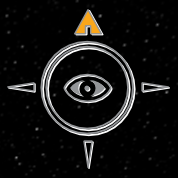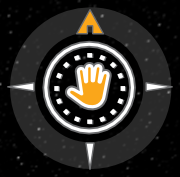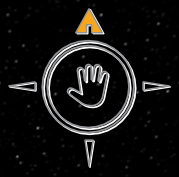Class ALcdCompassNavigationControl
- All Implemented Interfaces:
ImageObserver,MenuContainer,Serializable,Accessible
- Direct Known Subclasses:
TLcdGXYCompassNavigationControl,TLspCompassNavigationControl
- a draggable rotation indicator, that can be used to change an angle.
- a central area that can be used to change a two dimensional point. This point will correspond with the position of the mouse cursor ( or an other input method ) with respect to the center of the component.
getAngle() and getPoint(). They
are updated based on received mouse events. You can drag the outer ring to change the angle, and
pressing or dragging the mouse anywhere else in the component will change the point.
Usually implementations will want to know when one of these values is changed internally, as a
consequence of mouse events directly on the component. A subclass therefore has to implement certain
abstract methods. For the angle, this is the method angleChanged(). A call to this method
will notify the implementing class that it may use a new angle value (retrieved with getAngle())
to interact with a view (e.g. its rotation) or other object. Note however that the angle can also
be changed by subclasses using the method setAngle(double). Subclasses can use this method to adjust
the angle when the mouse is not interacting with this component. This will typically be used to
make sure that the compass always points north on a rotation capable map.
As for the point, it is only available after a mouse pressed event is received and before a mouse
released event is received. These events trigger calls to the abstract methods interactionStarted()
and interactionTerminated() respectively. In this way they notify the implementing class that
between these calls, the method getPoint() will return a point that can be used to
interact with a view or other object. Usually this point will be used to pan or rotate a view. A
call to startInteraction can for instance start a timer that will periodically check
the value returned by getPoint to pan the view until the timer is stopped by a call
to endInteraction .
The appearance of this component is specified by a number of images. Furthermore the appearance
can be changed at runtime. The method setEnabled(boolean) can be used to toggle between
an active and an inactive appearance. By default the active appearance is only used when the mouse
hovers over the component. The active/inactive appearance is usually shared with a few other
(navigation control) components. See TLcdMouseOverGroup
for more details.
The exact appearance is specified by the following images in png format:
- compass_arrows_inactive.png: the arrows that indicate the compass direction, when the navigation panel is inactive.
- compass_circles_inactive.png: The center of the panel when the navigation panel is inactive. This image will be used when the panel is not in pan mode.
- compass_arrows.png: the arrows that indicate the compass direction, when the navigation panel is active
- compass_circles.png: The center of the panel when the navigation panel is active. This image will be used when the panel is not in pan mode.
- compass_indicator_selected.png: the north arrow when the mouse hovers over it.
- compass_direction.png: the direction indicator when pressing or dragging the mouse over the panel.
- compass_ring_inactive.png: the draggable rotation ring when it isn't used.
- compass_ring.png: the draggable rotation ring when it is used.
Below you can see what the compass control looks like, using the default set of images. The two images at the right are used when the compass pans the view instead of looking around.




- Since:
- 10.0
- See Also:
-
Nested Class Summary
Nested classes/interfaces inherited from class javax.swing.JPanel
JPanel.AccessibleJPanelNested classes/interfaces inherited from class javax.swing.JComponent
JComponent.AccessibleJComponentNested classes/interfaces inherited from class java.awt.Container
Container.AccessibleAWTContainerNested classes/interfaces inherited from class java.awt.Component
Component.AccessibleAWTComponent, Component.BaselineResizeBehavior, Component.BltBufferStrategy, Component.FlipBufferStrategy -
Field Summary
FieldsModifier and TypeFieldDescriptionstatic final StringDefault name of the subfolder in the navigation controls image folder containing all compass panel images.static final StringDefault name of the subfolder in the navigation controls image folder containing all compass panel images when the compass panel will be used for panning (in 2D for example).Fields inherited from class javax.swing.JComponent
listenerList, TOOL_TIP_TEXT_KEY, ui, UNDEFINED_CONDITION, WHEN_ANCESTOR_OF_FOCUSED_COMPONENT, WHEN_FOCUSED, WHEN_IN_FOCUSED_WINDOWFields inherited from class java.awt.Component
accessibleContext, BOTTOM_ALIGNMENT, CENTER_ALIGNMENT, LEFT_ALIGNMENT, RIGHT_ALIGNMENT, TOP_ALIGNMENTFields inherited from interface java.awt.image.ImageObserver
ABORT, ALLBITS, ERROR, FRAMEBITS, HEIGHT, PROPERTIES, SOMEBITS, WIDTH -
Constructor Summary
ConstructorsConstructorDescriptionALcdCompassNavigationControl(String aImagePath) A constructor for the compass component. -
Method Summary
Modifier and TypeMethodDescriptionprotected abstract voidThis method is called whenever theanglehas been changed by direct interaction with the component (received mouse events).protected doublegetAngle()This method returns the rotation angle currently used to draw rotating parts of the component.Returns the magnetic north map to be used to point to the magnetic north.Returns the dimension specified by the images used.Returns the dimension specified by the images used.protected Point2D.DoublegetPoint()This method returns a point that represents where the mouse is located over the panel.Returns the dimension specified by the images used.Returns the tool tip string that has been set with setRingToolTipText.getToolTipText(MouseEvent event) Returns the tool tip string that has been set with setUpArrowToolTipText.protected abstract voidThis method will be called when the mouse starts interacting with the panel (except when it's interacting with the draggable rotation ring).protected abstract voidThis method will be called when the mouse stops interacting with the panel.protected voidsetAngle(double aAngle) Sets the rotation angle of the rotating parts of the component.voidsetEnabled(boolean enabled) voidsetMagneticNorthMap(ILcdMagneticNorthMap aMagneticNorthMap) Lets the compass point to the magnetic north instead of true north, using the given magnetic north map.voidsetRingToolTipText(String aRingToolTipText) Registers the text to display in a tool tip when the cursor lingers over the up arrow of the this compass navigation control.voidsetUpArrowToolTipText(String aUpArrowToolTipText) Registers the text to display in a tool tip when the cursor lingers over the up arrow of the this compass navigation control.Methods inherited from class javax.swing.JPanel
getAccessibleContext, getUI, getUIClassID, paramString, setUI, updateUIMethods inherited from class javax.swing.JComponent
addAncestorListener, addNotify, addVetoableChangeListener, computeVisibleRect, contains, createToolTip, disable, enable, firePropertyChange, firePropertyChange, firePropertyChange, fireVetoableChange, getActionForKeyStroke, getActionMap, getAlignmentX, getAlignmentY, getAncestorListeners, getAutoscrolls, getBaseline, getBaselineResizeBehavior, getBorder, getBounds, getClientProperty, getComponentGraphics, getComponentPopupMenu, getConditionForKeyStroke, getDebugGraphicsOptions, getDefaultLocale, getFontMetrics, getGraphics, getHeight, getInheritsPopupMenu, getInputMap, getInputMap, getInputVerifier, getInsets, getInsets, getListeners, getLocation, getNextFocusableComponent, getPopupLocation, getRegisteredKeyStrokes, getRootPane, getSize, getToolTipLocation, getToolTipText, getTopLevelAncestor, getTransferHandler, getVerifyInputWhenFocusTarget, getVetoableChangeListeners, getVisibleRect, getWidth, getX, getY, grabFocus, hide, isDoubleBuffered, isLightweightComponent, isManagingFocus, isOpaque, isOptimizedDrawingEnabled, isPaintingForPrint, isPaintingOrigin, isPaintingTile, isRequestFocusEnabled, isValidateRoot, paint, paintBorder, paintChildren, paintComponent, paintImmediately, paintImmediately, print, printAll, printBorder, printChildren, printComponent, processComponentKeyEvent, processKeyBinding, processKeyEvent, processMouseEvent, processMouseMotionEvent, putClientProperty, registerKeyboardAction, registerKeyboardAction, removeAncestorListener, removeNotify, removeVetoableChangeListener, repaint, repaint, requestDefaultFocus, requestFocus, requestFocus, requestFocusInWindow, requestFocusInWindow, resetKeyboardActions, reshape, revalidate, scrollRectToVisible, setActionMap, setAlignmentX, setAlignmentY, setAutoscrolls, setBackground, setBorder, setComponentPopupMenu, setDebugGraphicsOptions, setDefaultLocale, setDoubleBuffered, setFocusTraversalKeys, setFont, setForeground, setInheritsPopupMenu, setInputMap, setInputVerifier, setMaximumSize, setMinimumSize, setNextFocusableComponent, setOpaque, setPreferredSize, setRequestFocusEnabled, setToolTipText, setTransferHandler, setUI, setVerifyInputWhenFocusTarget, setVisible, unregisterKeyboardAction, updateMethods inherited from class java.awt.Container
add, add, add, add, add, addContainerListener, addImpl, addPropertyChangeListener, addPropertyChangeListener, applyComponentOrientation, areFocusTraversalKeysSet, countComponents, deliverEvent, doLayout, findComponentAt, findComponentAt, getComponent, getComponentAt, getComponentAt, getComponentCount, getComponents, getComponentZOrder, getContainerListeners, getFocusTraversalKeys, getFocusTraversalPolicy, getLayout, getMousePosition, insets, invalidate, isAncestorOf, isFocusCycleRoot, isFocusCycleRoot, isFocusTraversalPolicyProvider, isFocusTraversalPolicySet, layout, list, list, locate, minimumSize, paintComponents, preferredSize, printComponents, processContainerEvent, processEvent, remove, remove, removeAll, removeContainerListener, setComponentZOrder, setFocusCycleRoot, setFocusTraversalPolicy, setFocusTraversalPolicyProvider, setLayout, transferFocusDownCycle, validate, validateTreeMethods inherited from class java.awt.Component
action, add, addComponentListener, addFocusListener, addHierarchyBoundsListener, addHierarchyListener, addInputMethodListener, addKeyListener, addMouseListener, addMouseMotionListener, addMouseWheelListener, bounds, checkImage, checkImage, coalesceEvents, contains, createImage, createImage, createVolatileImage, createVolatileImage, disableEvents, dispatchEvent, enable, enableEvents, enableInputMethods, firePropertyChange, firePropertyChange, firePropertyChange, firePropertyChange, firePropertyChange, firePropertyChange, getBackground, getBounds, getColorModel, getComponentListeners, getComponentOrientation, getDropTarget, getFocusCycleRootAncestor, getFocusListeners, getFocusTraversalKeysEnabled, getFont, getForeground, getGraphicsConfiguration, getHierarchyBoundsListeners, getHierarchyListeners, getIgnoreRepaint, getInputContext, getInputMethodListeners, getInputMethodRequests, getKeyListeners, getLocale, getLocation, getLocationOnScreen, getMouseListeners, getMouseMotionListeners, getMousePosition, getMouseWheelListeners, getName, getParent, getPropertyChangeListeners, getPropertyChangeListeners, getSize, getToolkit, getTreeLock, gotFocus, handleEvent, hasFocus, imageUpdate, inside, isBackgroundSet, isCursorSet, isDisplayable, isEnabled, isFocusable, isFocusOwner, isFocusTraversable, isFontSet, isForegroundSet, isLightweight, isMaximumSizeSet, isMinimumSizeSet, isPreferredSizeSet, isShowing, isValid, isVisible, keyDown, keyUp, list, list, list, location, lostFocus, mouseDown, mouseDrag, mouseEnter, mouseExit, mouseMove, mouseUp, move, nextFocus, paintAll, postEvent, prepareImage, prepareImage, processComponentEvent, processFocusEvent, processHierarchyBoundsEvent, processHierarchyEvent, processInputMethodEvent, processMouseWheelEvent, remove, removeComponentListener, removeFocusListener, removeHierarchyBoundsListener, removeHierarchyListener, removeInputMethodListener, removeKeyListener, removeMouseListener, removeMouseMotionListener, removeMouseWheelListener, removePropertyChangeListener, removePropertyChangeListener, repaint, repaint, repaint, requestFocus, requestFocus, requestFocusInWindow, resize, resize, setBounds, setBounds, setComponentOrientation, setCursor, setDropTarget, setFocusable, setFocusTraversalKeysEnabled, setIgnoreRepaint, setLocale, setLocation, setLocation, setMixingCutoutShape, setName, setSize, setSize, show, show, size, toString, transferFocus, transferFocusBackward, transferFocusUpCycle
-
Field Details
-
COMPASS_COMPONENT_DIR
Default name of the subfolder in the navigation controls image folder containing all compass panel images.- See Also:
-
COMPASSPAN_COMPONENT_DIR
Default name of the subfolder in the navigation controls image folder containing all compass panel images when the compass panel will be used for panning (in 2D for example). The default images show a hand instead of an eye then.- See Also:
-
-
Constructor Details
-
ALcdCompassNavigationControl
A constructor for the compass component. The constructor also loads the necessary images and will initialize all the subcomponents of the panel.The default image path is usually the path to the root folder of the navigation controls +
COMPASS_COMPONENT_DIRorCOMPASSPAN_COMPONENT_DIR. The directoryCOMPASSPAN_COMPONENT_DIRshould contain a set of images to be used when the compass will be able to pan the view. These constants can be used by factory methods to create a complete set of navigation controls with a single path to a root folder.- Parameters:
aImagePath- The (relative or absolute) path to the directory where the images are stored. For relative paths, the classpath and the working directory are searched.- Throws:
IOException- when one of the necessary images is missing.
-
-
Method Details
-
setEnabled
public void setEnabled(boolean enabled) - Overrides:
setEnabledin classJComponent
-
getCursor
-
setMagneticNorthMap
Lets the compass point to the magnetic north instead of true north, using the given magnetic north map.- Parameters:
aMagneticNorthMap- the map to use. If null, the compass will point to the true north
-
getMagneticNorthMap
Returns the magnetic north map to be used to point to the magnetic north.- Returns:
- the map to use. If null, the compass will point to the true north
-
getAngle
protected double getAngle()This method returns the rotation angle currently used to draw rotating parts of the component.- Returns:
- The angle that indicates how far the compass is rotated. A return value of zero means the compass points straight up. A positive value means the compass is rotated clockwise (like a regular compass) over an angle equal to the value (in radians).
-
setAngle
protected void setAngle(double aAngle) Sets the rotation angle of the rotating parts of the component. Typically, the compass bearing is the inverse direction of this angle (i.e.bearing = -angle). This method is called internally in response to mouse events. Subclasses should call this method whenever the compass bearing changes, for instance during panning or if the view has been rotated by another controller.
Refer to theangleChanged()method to update the view if the user interacts with the compass.- Parameters:
aAngle- the angle to draw the rotating parts of the component, positive clockwise from 12 o'clock, in radians
-
angleChanged
protected abstract void angleChanged()This method is called whenever theanglehas been changed by direct interaction with the component (received mouse events). Implementations of this method should apply the angle (typically to an instance ofILcdView). The method should not be called by subclasses.- See Also:
-
getPoint
This method returns a point that represents where the mouse is located over the panel. It corresponds with the location of the mouse relative to the center of the component, but scaled using the Dimension of the panel, so the resulting X and Y values are between 1 and -1. Note: you should only use this method between a call tointeractionStarted()and a call tointeractionTerminated(). It will not return usable values at any other time.- Returns:
- a point representing the relative position of the mouse with respect to the center of the panel.
- See Also:
-
interactionStarted
protected abstract void interactionStarted()This method will be called when the mouse starts interacting with the panel (except when it's interacting with the draggable rotation ring). Between a call to this method and a call tointeractionTerminated()the methodgetPoint()will return a point that can be used to interact with an object.- See Also:
-
interactionTerminated
protected abstract void interactionTerminated()This method will be called when the mouse stops interacting with the panel. Between a call tointeractionStarted()and a call to this method, the methodgetPoint()will return a point that can be used to interact with an object.- See Also:
-
getRingToolTipText
Returns the tool tip string that has been set with setRingToolTipText.- Returns:
- the text of the tool tip for the part of the compass navigation control covered by the rotation ring.
- See Also:
-
setRingToolTipText
Registers the text to display in a tool tip when the cursor lingers over the up arrow of the this compass navigation control.- Parameters:
aRingToolTipText- the text to display in a tool tip over the up arrow, or null if no specific tool tip should be shown.- See Also:
-
getUpArrowToolTipText
Returns the tool tip string that has been set with setUpArrowToolTipText.- Returns:
- the text of the tool tip for the part of the compass navigation control covered by the up arrow.
- See Also:
-
setUpArrowToolTipText
Registers the text to display in a tool tip when the cursor lingers over the up arrow of the this compass navigation control.- Parameters:
aUpArrowToolTipText- the text to display in a tool tip over the up arrow, or null if no specific tool tip should be shown.- See Also:
-
getToolTipText
- Overrides:
getToolTipTextin classJComponent
-
getPreferredSize
Returns the dimension specified by the images used.- Overrides:
getPreferredSizein classJComponent- Returns:
- the size of the images this panel is a based on.
-
getMinimumSize
Returns the dimension specified by the images used.- Overrides:
getMinimumSizein classJComponent- Returns:
- the size of the images this panel is a based on.
-
getMaximumSize
Returns the dimension specified by the images used.- Overrides:
getMaximumSizein classJComponent- Returns:
- the size of the images this panel is based on.
-